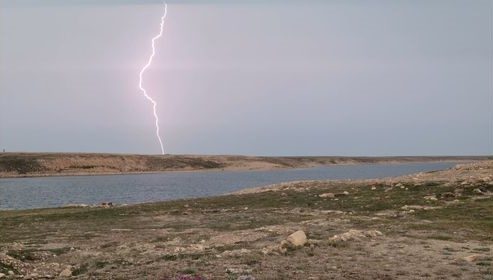Lightning strikes Nunavut from top to bottom
Lightning is rare in the Arctic, but becoming more common.

Nunavut is being hit with lightning from top to bottom because a “pretty significant heat wave” created the right conditions for a phenomenon that’s ordinarily uncommon in the North, a meteorologist with Environment and Climate Change Canada says.
Since Saturday, there have been reports of lightning strikes as far north as 79 degrees latitude near the Queen Elizabeth Islands and as far south as the middle of Hudson Bay.
A heat wave that started over the Northwest Territories and rolled slowly eastward is working its way across Nunavut now.
“These lightning strikes and this heat event are kind of linked,” said meteorologist Sara Hoffman.
[The high Arctic saw a huge spike in lightning last year]
On Wednesday, Cambridge Bay man Jamie Taipana said there were “numerous lightning strikes.”
Storms “are becoming more of an occurrence,” said Taipana, who snapped a photo of one the lightning bolts.
“We had one last year, but this one was much stronger and moved over from Kugluktuk and [the] mainland as it stormed there yesterday,” he wrote in a Facebook message.
Wednesday’s storm came in around 8 a.m. and lasted about 90 minutes. It brought heavy rain as well, said Taipana, a Government of Nunavut worker in Cambridge Bay, where he lives with his wife, Lisa, and daughter Erica. He moved there from Kugluktuk more than 20 years ago.
He said Cambridge Bay has had “moderate rain” during previous storms, but Wednesday was the first time he had seen such heavy downfall.
On Saturday, Ryan Voutilainen, a Vancouver man with “a love for earth sciences” — especially storms — posted on Twitter about a lightning strike at 79 degrees north latitude — in the Arctic Ocean.
He was using an app called My Lightning Tracker that pinpointed the location of a strike at 12:43 a.m. Saturday off Borden Island, one of the Queen Elizabeth Islands in northwest Nunavut.
“Not often you see a #lightning strike at 79°N in the #ArcticOcean — wonder if any chasers in #Nunavut or #NorthWestTerritories caught it?” he wrote on Saturday afternoon.
Historically, lightning has been rare in Canada’s North, Hoffman said.
“It has happened before, but it’s not very common. It does happen,” she said.
Lightning occurs when there’s an unstable moist air mass and water particles rise high into the sky. When the cooling particles fall and come in contact with a warmer air mass, the conditions are right for lightning, Hoffman said.
The stable cool temperatures of Canada’s North traditionally don’t allow for the “really deep instability” needed to create lightning, she said.
Lightning is becoming increasingly common, however, because climate change is causing the Arctic to warm more quickly than other parts of the country.
While Hoffman was talking on the phone to Nunatsiaq News, she noticed the My Lightning Tracker app showed strikes northwest of Resolute Bay and in Hudson Bay, just north of James Bay.
Overall, Environment and Climate Change Canada has “spotty” records on lightning in Nunavut because the federal department does not have a good method of tracking lightning north of the tree line, she said.